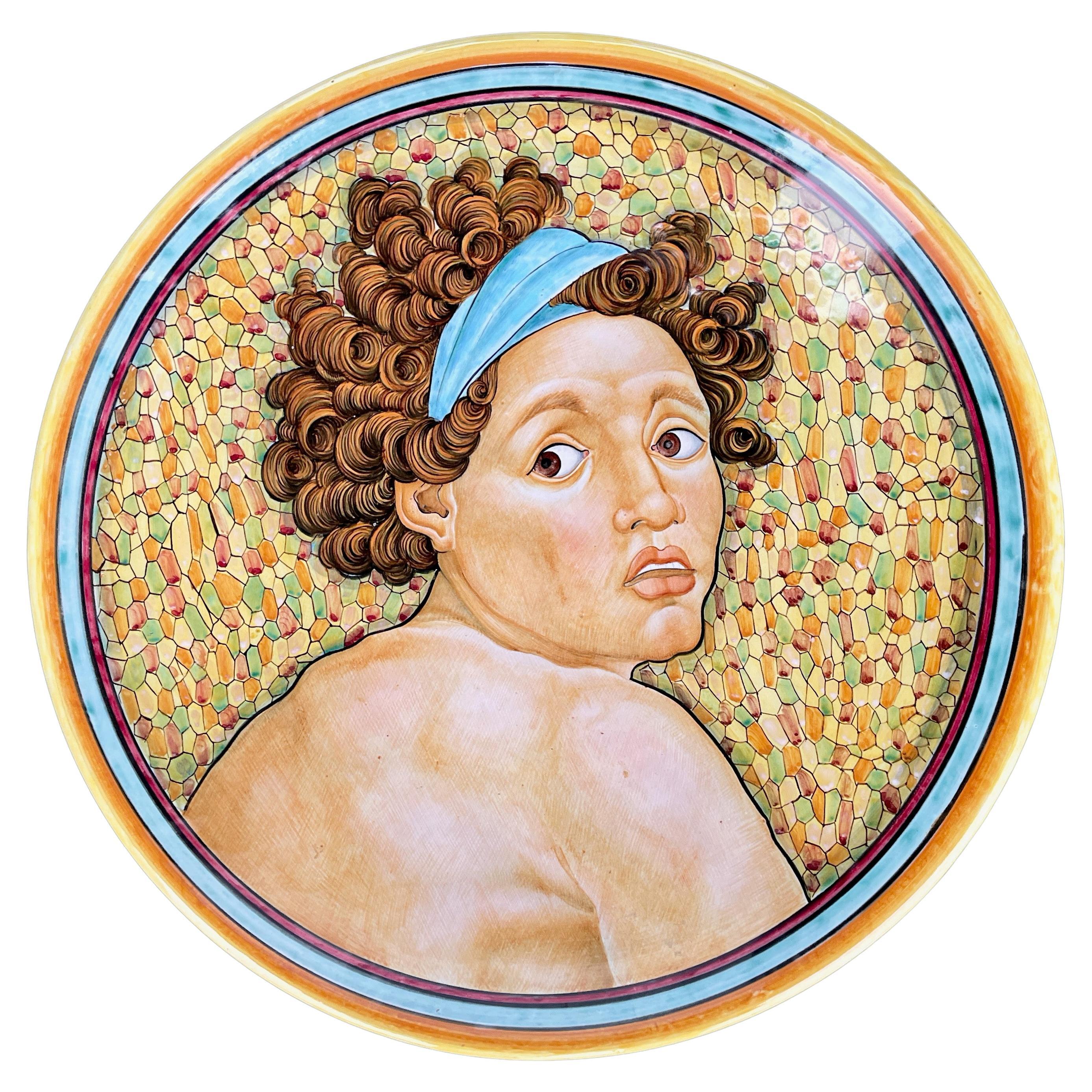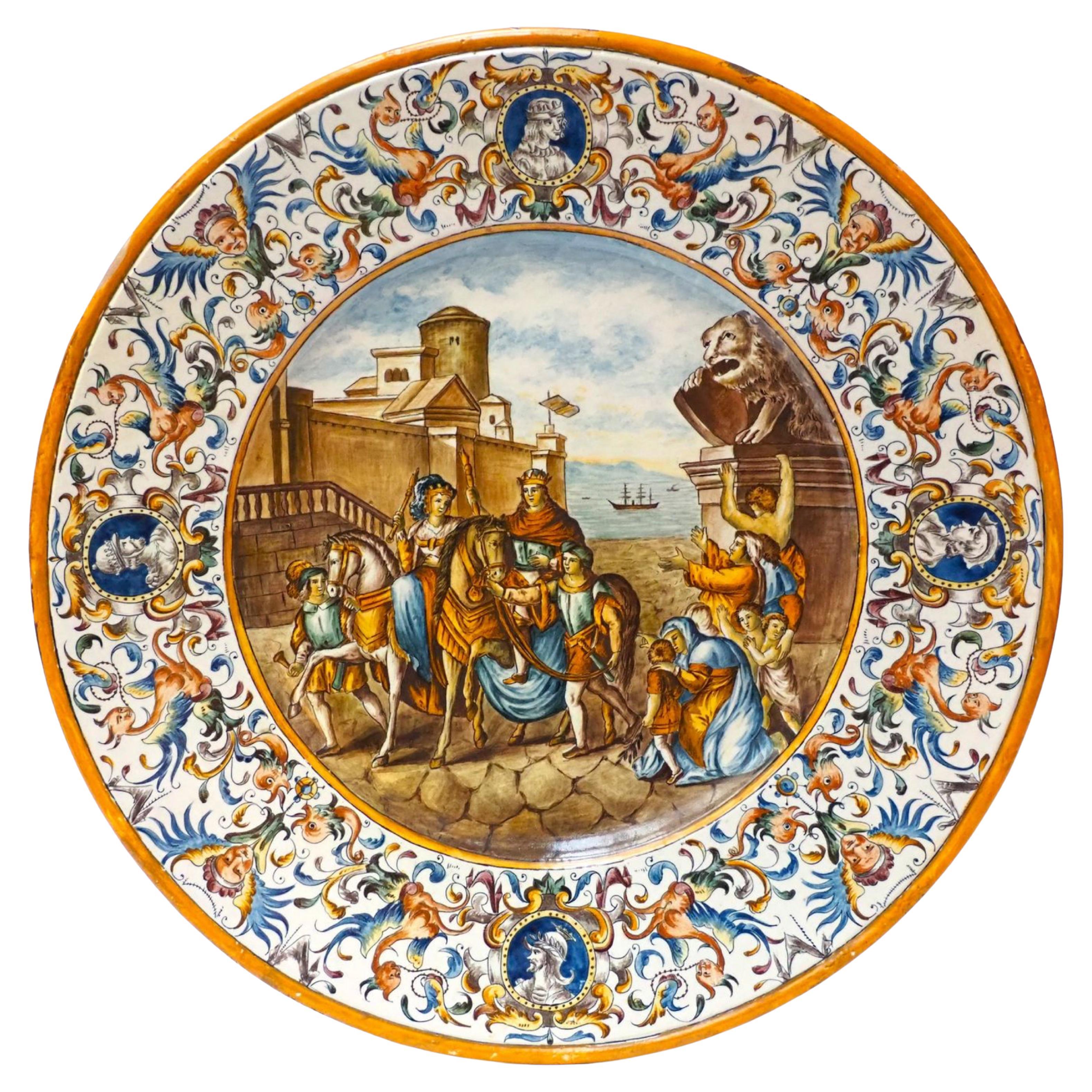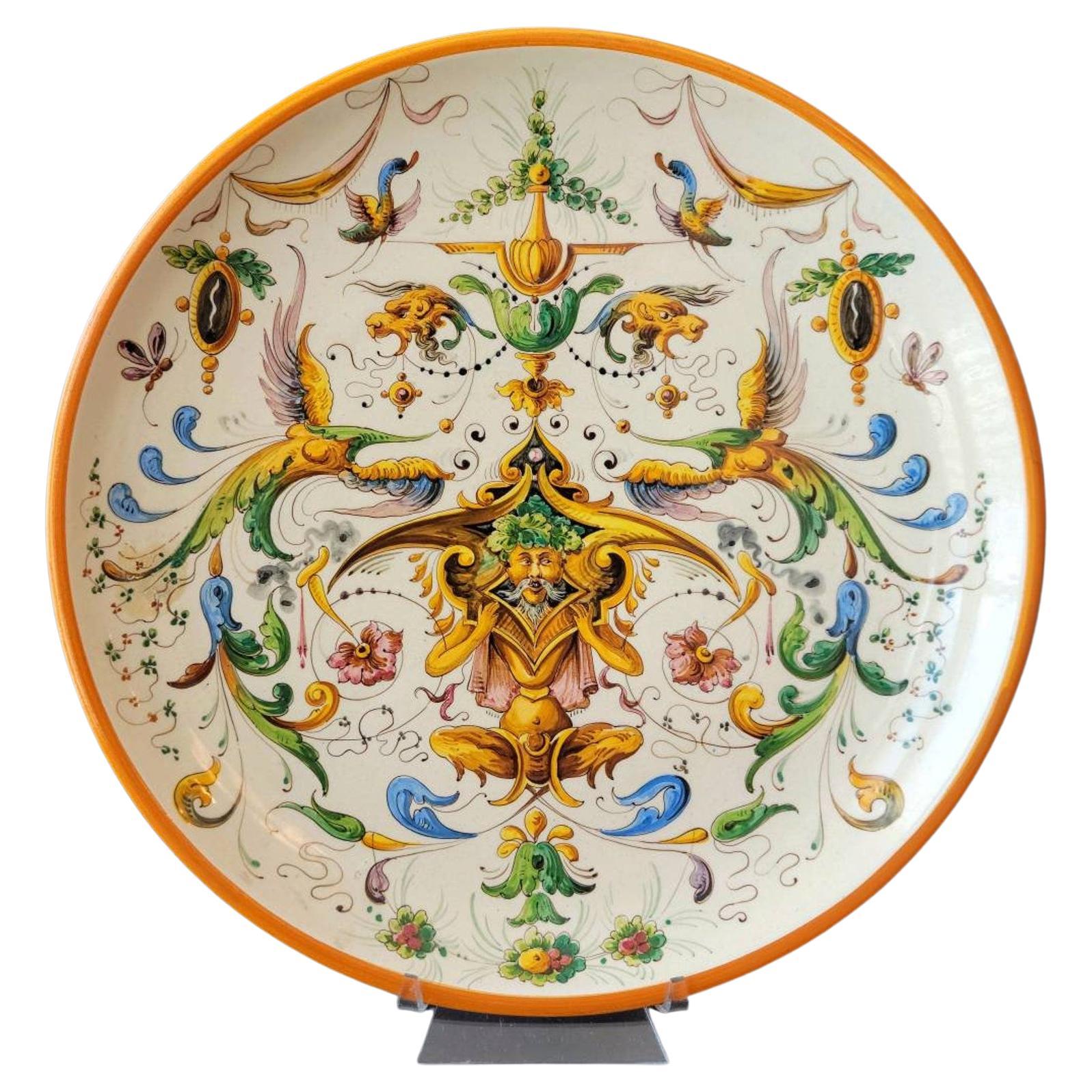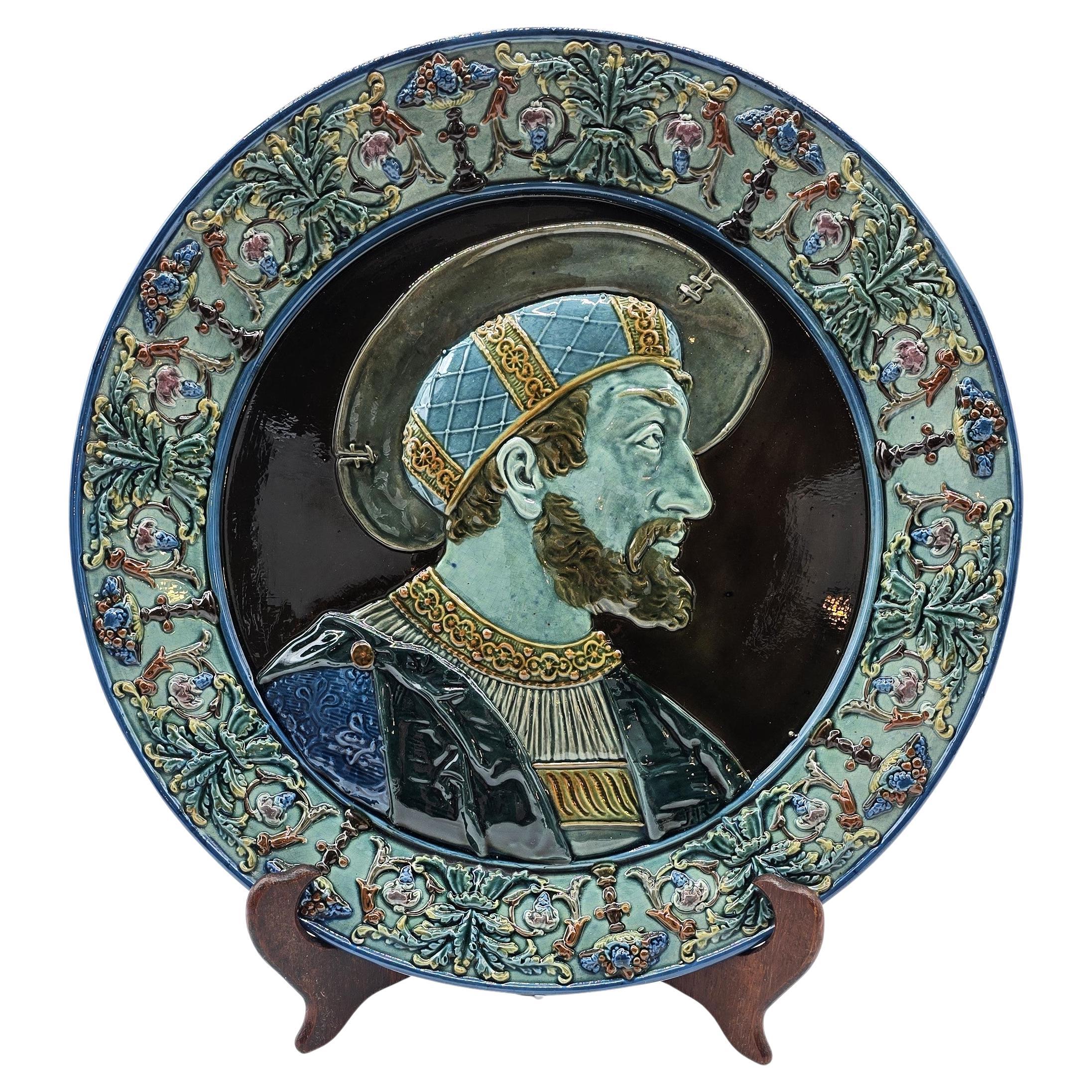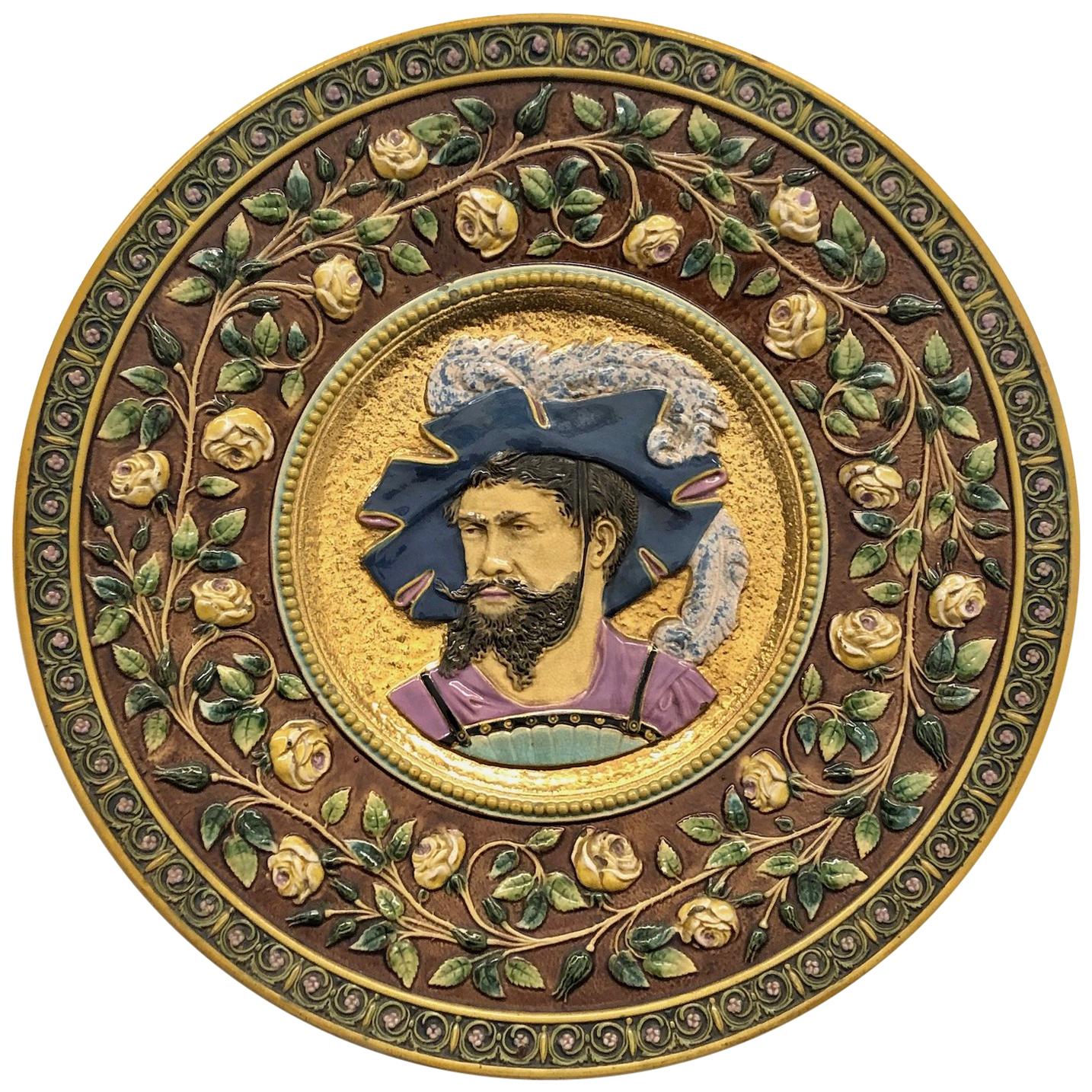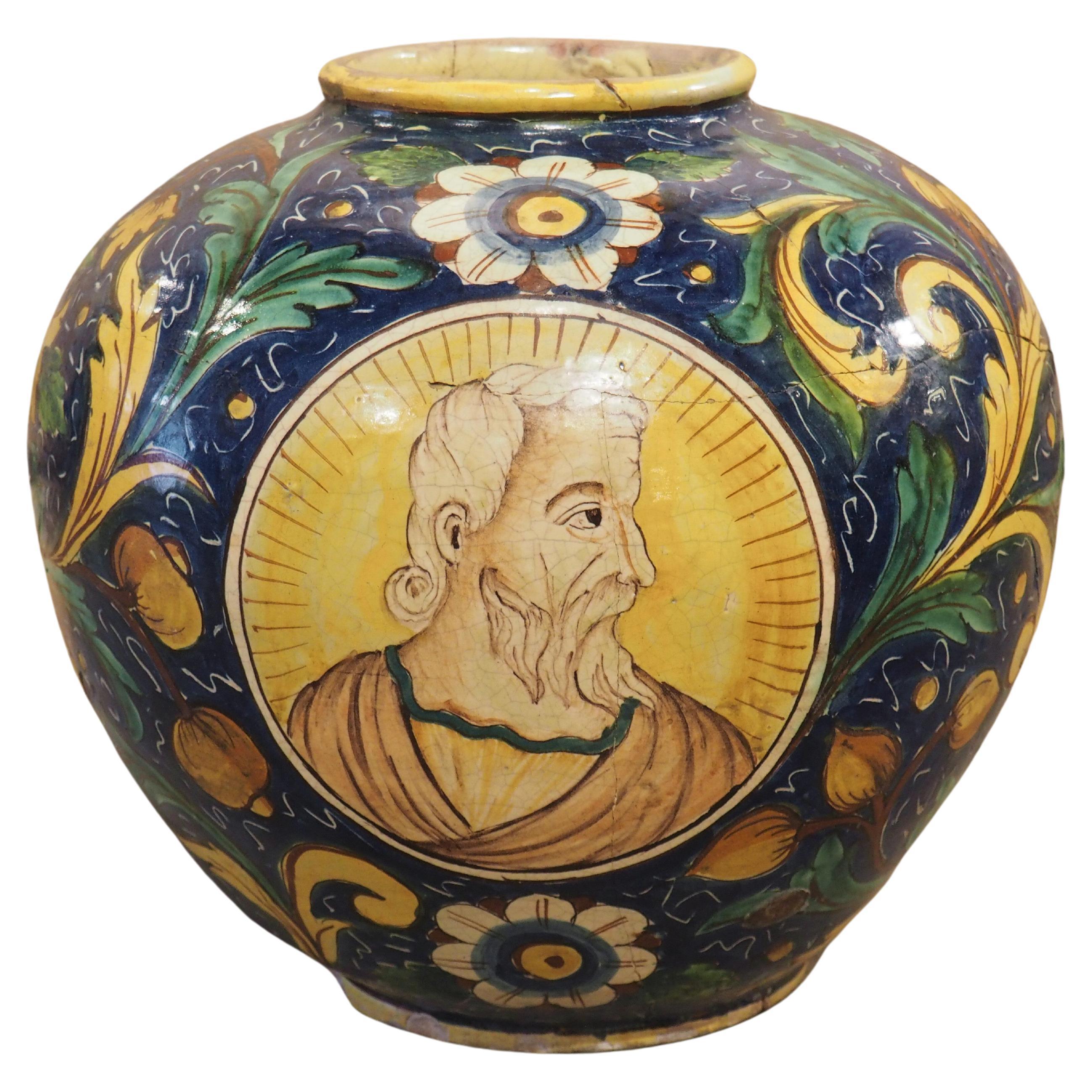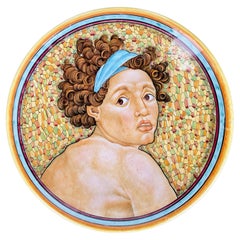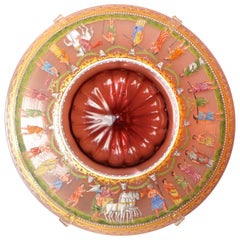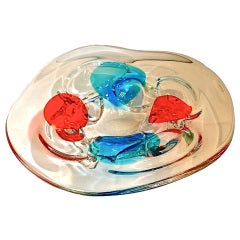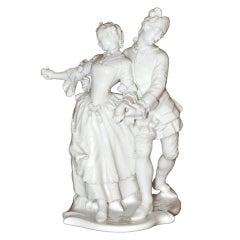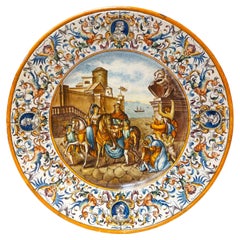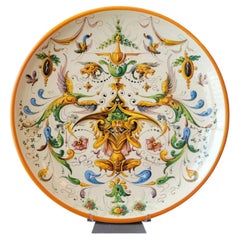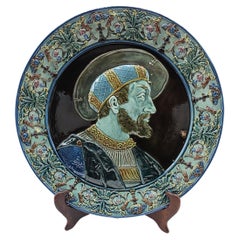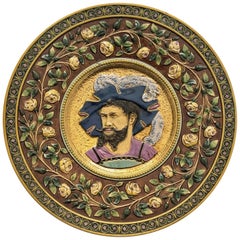Items Similar to Serafino Volpi Deruta Charger with Portrait of Zaccaria
Want more images or videos?
Request additional images or videos from the seller
1 of 10
Serafino Volpi Deruta Charger with Portrait of Zaccaria
$980
£744.14
€850.98
CA$1,369.20
A$1,522.85
CHF 795.19
MX$18,531.48
NOK 10,155.74
SEK 9,524.29
DKK 6,351.16
Shipping
Retrieving quote...The 1stDibs Promise:
Authenticity Guarantee,
Money-Back Guarantee,
24-Hour Cancellation
About the Item
Deruta majolica charger from the workshop of Serafino Volpi hand painted with the portrait of the prophet Zaccaria from Michaelangelo's Sistine Chapel ceiling. On the back it is somewhat illegibly signed by the artist and there is remnants of a paper label, possibly a price tag and wire for wall hanging.
See our separate listing for a companion charger.
Serafino Volpi was a major force in establishing 20th century Deruta as one of Italy’s most important pottery producing centers, thereby making it famous worldwide. Volpi was a painter, a ceramicst, a businessman and above all, one of the most innovative and daring artist to live in a town filled with some of the brightest and most talented artists Italy had to offer in the first half of the 20th century.
In 1916, Volpi’s talent and innovation brought him to the attention of the Maiolica Deruta company, where he was hired as the Technical Director. In 1919 he left the firm to become one of the founders of the Grazia company (which is still in operation today). Then, in 1928, along with Gino Veschini, he created Maiolica Derutese. Volpi’s passion for the ceramics arts, his friendships and collaborations with such master decorators as Amerigo Lunghi and Alpinolo Magnini and Volpi’s own talent launched the new company into immediate international recognition. The company remained in operation until 1970 under the guidance of Volpi’s son and grandchildren.
Serafino, ever the innovator and astute entrepreneur, was the first to see an opportunity to open a new market for his wares. His Maiolica Derutese was the first Italian company to introduce Italian arts and crafts to Japan immediately after World War II. His approach was unique and highly successful. He combined Japanese techniques, such as moriage and combined that with American themes such as cowboys and Indians, then very popular in Japan, and melded them together in a style that still remained distinctly Italian in flavor.
In the 1950's Volpi left the operation of Maiolica Derutese to his son and then opened a new studio-"S. Volpi". The pieces he produced during this period were distinctly not of traditional Deruta design but rather showed a more adventurous spirit. They were more modern and free flowing in style and Volpi always experimented with new shapes and colors. The company closed after a few short years of production.
- Creator:Volpi (Workshop/Studio)
- Dimensions:Height: 1.75 in (4.45 cm)Diameter: 18 in (45.72 cm)
- Style:Renaissance (In the Style Of)
- Materials and Techniques:
- Place of Origin:
- Period:
- Date of Manufacture:1950's
- Condition:Wear consistent with age and use. No issues. Ready to display.
- Seller Location:Hanover, MA
- Reference Number:1stDibs: LU886637057632
About the Seller
4.9
Platinum Seller
Premium sellers with a 4.7+ rating and 24-hour response times
Established in 2008
1stDibs seller since 2010
1,106 sales on 1stDibs
Typical response time: <1 hour
- ShippingRetrieving quote...Shipping from: Hanover, MA
- Return Policy
Authenticity Guarantee
In the unlikely event there’s an issue with an item’s authenticity, contact us within 1 year for a full refund. DetailsMoney-Back Guarantee
If your item is not as described, is damaged in transit, or does not arrive, contact us within 7 days for a full refund. Details24-Hour Cancellation
You have a 24-hour grace period in which to reconsider your purchase, with no questions asked.Vetted Professional Sellers
Our world-class sellers must adhere to strict standards for service and quality, maintaining the integrity of our listings.Price-Match Guarantee
If you find that a seller listed the same item for a lower price elsewhere, we’ll match it.Trusted Global Delivery
Our best-in-class carrier network provides specialized shipping options worldwide, including custom delivery.More From This Seller
View AllSerafino Volpi Deruta Charger
By Volpi
Located in Hanover, MA
Deruta majolica charger from the workshop of Serafino Volpi hand painted with the wide eyed curly haired head of an 'ignudo' figure wearing headband fr...
Category
Vintage 1950s Italian Renaissance Ceramics
Materials
Ceramic
Pauly & C. Murano Glass Polychrome Enameled and Gilt Charger
By Salviati
Located in Hanover, MA
Venetian polychrome enameled and gilt handblown glass centerpiece by Pauly & C. of Murano of omphalos form in transparent red colored glass enameled by Francesco Toso Borella after a...
Category
Antique Early 1900s Italian Neoclassical Revival Centerpieces
Materials
Murano Glass
$3,450 Sale Price
40% Off
Murano Glass Charger Attributed to Fulvio Bianconi for Cenedese
By Fulvio Bianconi
Located in Hanover, MA
A large Murano glass bowl, unsigned, attributed to Fulvio Bianconi for Cenedese. Heavy clear glass with blue and red inclusions.
Category
Vintage 1950s Italian Platters and Serveware
Franz Anton Bustelli for Nymphenberg - Läufer mit Consortin
By Nymphenburg Porcelain, Franz Anton Bustelli
Located in Hanover, MA
Franze Anton Bustelli, one of the most important porcelain modellers of the Rococo, in 1754 for PORZELLAN MANUFAKTUR NYMPHENBURG. Porcelain, glazed, sculpted representation of Consor...
Category
Vintage 1950s German Figurative Sculptures
Materials
Porcelain
Marcello Fantoni Signed Large Rectangular Glazed Ceramic Bowl
By Marcello Fantoni
Located in Hanover, MA
Marcello Fantoni glazed ceramic rectangular bowl with horses 15 ½” long, 10 ½” wide, and stands 3 ½” tall to the rim. Signed underside.
This historical bowl is a modified rectangle ...
Category
Vintage 1950s Italian Mid-Century Modern Ceramics
Materials
Ceramic
Arrigo Finzi Lidded Pot in Porcelain and Oro Zecchino
By Arrigo Finzi
Located in Hanover, MA
A stunning 1940 Italian white porcelain lidded pot finely decorated with Zodiac figures from classical antiquity in 24k "Oro Zecchino" by Arrigo Finzi.
Gilt ceramic lid.
Signed Finzi Oro Zecchino Made in Italy on underside of potiche and Hutschenreuther on underside of cover.
Finzi often hand painted his designs on Hutschenreuther and Heinrich blanks.
Arrigo Finzi was the only Italian silversmith to be selected to participate in the exhibition "Italy at work, her renaissance in design today", promoted by the CNA (Compagnia Nazionale Artigiana) and hosted by 12 important American museums from 1950-1952 to present the best of the decorative arts produced in Italy since the end of the war. For years now, his production has also extended to porcelain decorated in pure gold. In 1952 he opens a store of two floors in Via Manzoni 17 in Milan and in 1954 he creates Finzi Arte, with the collaboration of his daughter Olga Finzi...
Category
Vintage 1940s Italian Mid-Century Modern Porcelain
Materials
Gold Leaf
You May Also Like
Gaetano BATTAGLIA (Naples-Italy-Active 1850 and 1885) Large Circular Plate
Located in Madrid, ES
Gaetano BATTAGLIA (Naples-Italy-Active between 1850 and 1885)
Large circular earthenware plate
in the style of Italian majolica with polychrome historiated decoration on the basin, t...
Category
Antique 19th Century Italian Rococo Ceramics
Materials
Majolica
Antique Italian Renaissance Raffaellesco Grotteschi Majolica Wall Charger
Located in Forney, TX
A stunning large antique Italian Raffaellesco majolica wall charger / centerpiece, showcasing exceptionally executed handmade and painted design, dating to the 19th century or earlie...
Category
Antique 19th Century Renaissance Ceramics
Materials
Majolica, Paint
An Austrian majolica pottery wall charger depicting a medieval man circa 1900
Located in Central England, GB
This superb large Austrian majolica pottery wall charger is highly decorative with its central finely moulded three dimensional Renaissance portrait of a medieval bearded noble man wearing an ornate tunic and matching hat.
The central portrait is boardered by a flared rim which is also ornately moulded with intricate floral decoration.
The beautiful coloured glazes used throughout this stunning charger are rich and translucent.
There are initials at the base of the portrait J R. On the reverse, the charger has an impressed L9 and a hand painted N...
Category
Early 20th Century Austrian Renaissance Pottery
Materials
Majolica, Pottery
Late 19th Century Hand Painted Majolica Plate with Nobleman Portrait German
Located in Nuernberg, DE
A large german majolica plate, circa 1880-1890s. The plate represent a german nobleman on a gold plated background surrounded by flowers.
Made ...
Category
Antique Late 19th Century German Late Victorian Decorative Art
Materials
Porcelain
Antique 19th Century Italian Maiolica Pot of the Renaissance Style
Located in Dallas, TX
Vivid colors, hand-painted in the Renaissance style, enhance this large maiolica pot from the 1800’s. Maiolica is tin-glazed pottery from Italy that has been decorated over a white background. This pot is considered an istoriato, which is to say that the pot has been decorated with figures, rather than strictly geometric patterns or floral designs.
The maiolica does incorporate floral and foliate motifs, with white flowers that have yellow centers surrounded by blue rings. There are also yellow flowers that are depicted in various stages of nyctinasty (the closing of flowers during the night). The flora is all connected by a series of green and yellow curled leaves. Behind the vegetation is a dark blue background. There are two portraits inside large yellow cartouches that are painted in the middle of the pot. The first is a bearded man, dressed in a light brown tunic...
Category
Antique 19th Century Italian Renaissance Vases
Materials
Maiolica
Important Plate Fratelli Minardi Faenza 1920 Art Deco
By Europa
Located in Madrid, ES
Important Plate Fratelli Minardi Faenza 1920
Lady's profile, a polychrome ceramic plate with a wide rim and a deep recess, with a ring-shaped support on the back, on a recessed back...
Category
Early 20th Century Italian Baroque Decorative Art
Materials
Maiolica, Porcelain
More Ways To Browse
Italian Charger
Italian Glass Charger
Deruta Hand
Vintage Cowboy Glasses
Italian Renaissance Pottery
Deruta Majolica
Italian Majolica Deruta
Moriage Japanese
Studio Pottery Chargers
Italian Deruta Pottery
Majolica Wall Hanging
Italian Ceramic Wall Hanging
Italian Majolica Charger
Vintage Deruta Pottery
Italian Pottery Charger
Charger Maiolica
Shorter And Sons Pottery
Deruta Charger
